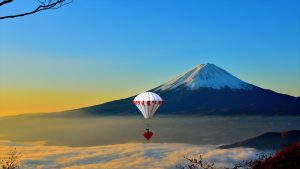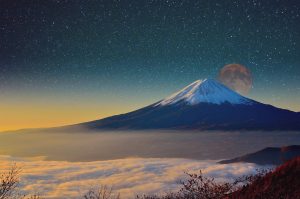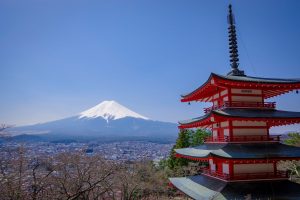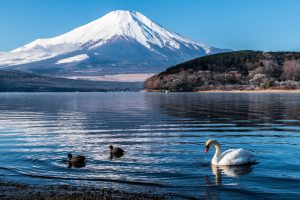 Rising to 12,388 feet, Mount Fuji is the tallest mountain in Japan and is known for its graceful conical form. It is the country’s sacred symbol, and temples and shrines are located around and on the volcano. In English, Fiji means; a spun silk clothing fabric in plain weave originally made in Japan. The average monthly temperature at the summit of Mt. Fuji is below freezing for almost all months, other than for a period of time in the summer, and has an average annual temperature of approximately −7ºC.
Rising to 12,388 feet, Mount Fuji is the tallest mountain in Japan and is known for its graceful conical form. It is the country’s sacred symbol, and temples and shrines are located around and on the volcano. In English, Fiji means; a spun silk clothing fabric in plain weave originally made in Japan. The average monthly temperature at the summit of Mt. Fuji is below freezing for almost all months, other than for a period of time in the summer, and has an average annual temperature of approximately −7ºC.
Tour Itinerary
Oshino Hakkai are the eight springs found in Oshino, Yamanashi, Japan. The aquifer water from Mount Fuji comes out to the ground to form these springs. They are a Natural monument of Japan, part of the Mount Fuji World Heritage Site, and one of Yamanashi Prefecture’s important tourist attractions.
Chureito Pagoda The five-storied Chureito Pagoda in Yamanashi Prefecture is a key part of Japan’s most recognizable landscape—the area around Mount Fuji. It honors those lost from the First Sino-Japanese War in 1868 all the way to WWII. Today, the pagoda stands proudly as the centerpiece for Arakura Sengen Shrine.
 Lake Kawaguchiko is the most easily accessible of the Fuji Five Lakes with train and direct bus connections to Tokyo. A hot spring resort town with various tourist attractions and views of Mount Fuji is located around the lake’s eastern end, while the northern and western shores are mostly undeveloped.
Lake Kawaguchiko is the most easily accessible of the Fuji Five Lakes with train and direct bus connections to Tokyo. A hot spring resort town with various tourist attractions and views of Mount Fuji is located around the lake’s eastern end, while the northern and western shores are mostly undeveloped.
Mt. Fuji Panoramic Ropeway ascends 400 meters from the eastern shore of Lake Kawaguchiko to an observation deck near the peak of Mount Tenjo. From the observation deck, which sits more than 1000 meters above sea level, there are panoramic views of the lake below and of Mount Fuji.
Oishi Park is one of the best spots to view Mt Fuji. The view from Oishi Park consists of Mt Fuji in the background, Kawaguchiko (Lake) in the mid ground and the lavender of Oishi Park in the foreground. The lavender blooms from the middle of June to the middle of July, which it means it is unlikely that Mt Fuji will have a snow cap.
 Saiko Iyashi no Sato Nemba Wander around this charming village and go back in time, exploring a replica of an old Japanese village. This is definitely one of the top attractions in the Fujikawaguchiko region. Lovely thatched roofed buildings stand facing Mount Fuji, these have been rebuilt with great attention to details after the village was destroyed by a landslide during a typhoon in the late sixties.
Saiko Iyashi no Sato Nemba Wander around this charming village and go back in time, exploring a replica of an old Japanese village. This is definitely one of the top attractions in the Fujikawaguchiko region. Lovely thatched roofed buildings stand facing Mount Fuji, these have been rebuilt with great attention to details after the village was destroyed by a landslide during a typhoon in the late sixties.
Arakura Fuji Sengen Shrine This scenic park located on the mountainside of Mt. Arakura and in front of Mt .Fuji, offers a panoramic view of the city. A lot of people enjoy cherry blossoms in the park in spring, and also enjoy hiking.
Mt. Fuji 5th Station Mt. Fuji attracts hikers and climbers from the world over, and most of them start their ascents at the 5th station, halfway up the mountain. You can have an amazing experience the atmosphere of this symbol of Japan, you can climb or drive to Fuji Subaru Line 5th Station for spectacular views. 
Gotemba Premium Outlets is regarded as Japan’s premium green tea growing area, with leaves grown at the foot of Mt. Fuji. Shizuoka prefecture is known to be the horseradish capital of Japan and Gotemba itself has several wasabi farms.